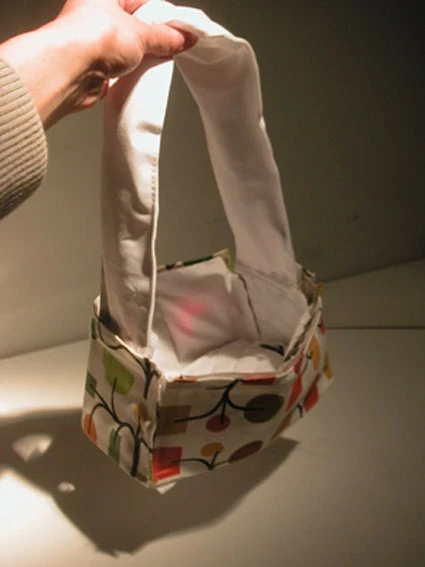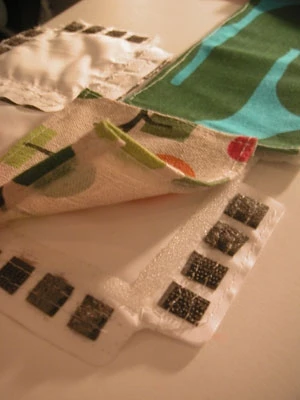November 14, 2004 A smart handbag has been created that tells the user if they have forgotten their keys or wallet, lights up when it gets dark and can wirelessly download information like weather reports from the internet and tell your umbrella it will be needed. The bYOB (Build Your Own Bag) is a flexible, computationally enhanced modular textile system that also transforms its shape according to your needs. When modules are snapped together to form an object, they communicate with people, other objects and their environment in a 'pervasive computing' network.
Adrian Cable, Gauri Nanda and Michael Bove from the Massachusetts Institute of Technology (MIT) Media Lab were motivated by a desire to transform everyday surfaces into ambient displays for information and to make building with fabric patches as easy as playing with Lego blocks.
The current bYOB prototype consists of squares and equilateral triangles approximately 4"x4" and no more than 1/8" thick. The simple geometries of squares and triangles were chosen because they are easily recognisable and can be effortlessly manipulated into two and three-dimensional shapes. Additionally, the dimensions were chosen to fit comfortably when grasped by the human hand.
The circuit board inside each patch is coated with a hard transparent resin to keep it waterproof and then padded with a thin layer of foam and encased in fabric. Extra components, from Bluetooth transmitters to a streamlined PC motherboard can then be integrated into the smart patch which is then joined using modified Velcro to enable electrical as well as physical connections. Wires from the circuit board are attached to silver-coated contacts in the Velcro. In this way, data and power can flow from one module to the next.
While all of the functionality of the system could have been pooled into one bag, the bYOB designers decided on a modular approach that gives people tangible control over the aesthetics and behaviours with no programming required. bYOB's significance is that anyone can make an object at any time and anywhere whether they are a designer with a new vision, an office worker in need of additional light, or a student who needs useful information while in transit but does not want to carry several additional electronic devices. For example, a set of bYOB modules may be physically configured into a window shade or lighting fixture in the office and later be reconfigured into a bag or scarf to aid the user in transit. Of course, the modules can easily be added to regular bags. "You could wear a system as a scarf today and a belt tomorrow," Dr Bove says.
Pervasive Computing
Using radio frequency identification, bYOB modules can detect whether or not important objects (e.g. mobile phones, wallets) are nearby and alert the user via the fabric's ambient light display, or by using speech if the items are missing. For example, a bYOB-constructed bag will light up to inform the user if he or she tries to leave home without keys. A voice module patch can warn "Mobile, yes! Wallet, yes! Keys, no!"
The sensors in the bag are the latest advance in the new field of 'pervasive computing', which is concerned with the integration of communication and information technology into the clothes, materials and the environment around us. Researchers have already enabled sensors and computers worn in jackets and clothing, but they are locked into single use functionality and cannot be reconfigured. With the new smart patches, however, a user can swap modules to use the system for a variety of functions.
The MIT engineers envisage a day when the smart fabrics are synchronized together into a pervasive computing network that allows intuitive use and seamless integration into 21st century lifestyles. When you hang your bag up for the day, it will automatically recharge its battery and synchronise itself with other objects in the bYOB network. They also plan to use a Bluetooth chip to download information from the internet (e.g. weather forecasts, stock market feeds, news updates) to the modules. Additionally, the user will have the ability to 'log in' to one or more remote bYOB bags from a computer and search for the location of items.
"People would add functionality to their bag, just as they download ringtones for their phones today," Dr Bove said.
Constructed from inexpensive, off-the-shelf electrical components, the bYOB bags could soon be commercially available for around the same as an ordinary leather handbag.












